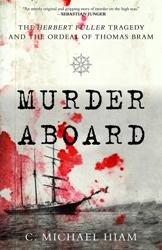 Pirates and Privateers Pirates and Privateers
The History of Maritime
Piracy
Cindy Vallar, Editor
& Reviewer
P.O. Box 425,
Keller, TX 76244-0425
    
Books for
Adults ~ Disasters, Mutinies, & Shipwrecks

Murder Aboard: The Herbert
Fuller Tragedy and the Ordeal of Thomas Bram
by C. Michael Hiam
Lyons Press, 2019, ISBN 978-1-4930-4131-2, US $26.95
Also available in other formats
    
On 3 July
1896, Herbert Fuller left Boston. Ten days
later, the captain, his wife, and the second mate
were dead. Murdered with an ax while they slept.
Surrounded by ocean, that meant someone on board had
done the horrendous deed and any one of the
survivors could be next.
There was no inkling of anything out of the ordinary
before that fateful night. The barkentine carried a
cargo of white pine bound for South America on a
journey that should have taken about two months.
There were twelve people aboard the ship, including
Lester Hawthorne Monks, a student at Harvard
University. That night, before going to sleep, he
read a story of mutiny and murder by William Clark
Russell. Sometime after he retired, he was awakened
by a scream. When he went to investigate, he found
Captain Charles Nash dead. Later, he and the steward
also found the bodies of Laura Nash and August
Blomberg.
Soon after, the remaining nine men aboard decided to
preserve the bodies and some of the evidence and to
sail for Halifax, Nova Scotia, which they deemed the
closest port where they could report the murders.
They also tried to determine who did the deed. The
most likely suspect was Charley Brown, a Swedish
sailor who acted suspiciously. But perhaps Thomas
Bram, the first mate, was the murderer. Or maybe the
two acted together. Whatever the truth, surely the
authorities in Halifax would find the answer. If not
them, the Americans would since the victims were
American, Herbert Fuller was American, and
she had departed from an American port.
What ensues, however, is an account of questionable
justice rife with lies, exaggerations, racism, and
manipulation. No one, not even the passenger Monks,
the victims, the sailors, or even the attorney who
prosecutes the case, are above reproach. Only one
victim supposedly gets justice, because errors made
by the grand jury mean the defendant can be tried
for only one murder. Black-&-white pictures and
diagrams, some submitted as evidence, are included,
as are a bibliography and index.
Hiam provides an insightful and riveting account of
the days before, during, and after the murders are
committed. He shows how even some of the
participants and those who follow the proceedings
question the findings and the verdicts. It is also a
compelling commentary on society and the legal
system in the final years of the 19th century.
Review
Copyright ©2023 Cindy Vallar

Click to contact me
Background image compliments
of Anke's Graphics |

